The Lobby
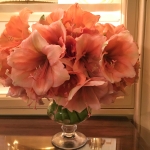 While peach colored amaryllis are popular for cutflower use, old clones like 'Bouquet' and 'Rilona' do most of the heavy lifting. This variety didn't quite seem like those, but did nicely match a photo on a wholesaler's site for 'Acapella'. Photographed 2016.
While peach colored amaryllis are popular for cutflower use, old clones like 'Bouquet' and 'Rilona' do most of the heavy lifting. This variety didn't quite seem like those, but did nicely match a photo on a wholesaler's site for 'Acapella'. Photographed 2016.
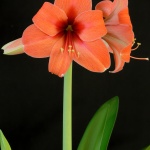 2010, Berbee Amarylliscultures. Grown primarily for the European cut-flower market, this one escaped in a box kit marked ‘Amigo’. Beautiful warm apricot orange with hints of flamingo rose near the inner midribs. An exquisite amaryllis; unfortunately this one showed virus symptoms upon growing out. The image is a terrific match for the registry description and stock photos, but certainty is not 100%.
2010, Berbee Amarylliscultures. Grown primarily for the European cut-flower market, this one escaped in a box kit marked ‘Amigo’. Beautiful warm apricot orange with hints of flamingo rose near the inner midribs. An exquisite amaryllis; unfortunately this one showed virus symptoms upon growing out. The image is a terrific match for the registry description and stock photos, but certainty is not 100%.
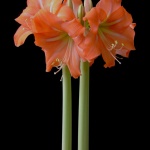 This beautiful amaryllis showed up at retailers for a couple of years around 2003-2005, then seemingly disappeared. A nice "mini" with soft orange and white blooms. Quite beautiful, and favored over the paler and more pinkish 'Amoretta.' Emaryllis finds that it does still show up on the Leo Berbee (North America) site. It is unclear whether this is the same 'Table Decoration' as registered by Ludwig/Berbee in 1967. Like a miniature 'Nagano.'
This beautiful amaryllis showed up at retailers for a couple of years around 2003-2005, then seemingly disappeared. A nice "mini" with soft orange and white blooms. Quite beautiful, and favored over the paler and more pinkish 'Amoretta.' Emaryllis finds that it does still show up on the Leo Berbee (North America) site. It is unclear whether this is the same 'Table Decoration' as registered by Ludwig/Berbee in 1967. Like a miniature 'Nagano.'
 Purchased as a box kit labeled as 'Red Sensation'. It turned out not to be the huge scarlet red amaryllis expected, but this extremely dark and silky red of modest size and impeccable form. The red is so dark, so even, and the form is so flawless that this simply can not be some un-named seedling. My suspicion is that it is 'Dordogne', which has been produced for the cutflower industry. An absolutely stunning flower. There may be more and more fine hybrids with nearly black red coloration, but this one is still special.
Purchased as a box kit labeled as 'Red Sensation'. It turned out not to be the huge scarlet red amaryllis expected, but this extremely dark and silky red of modest size and impeccable form. The red is so dark, so even, and the form is so flawless that this simply can not be some un-named seedling. My suspicion is that it is 'Dordogne', which has been produced for the cutflower industry. An absolutely stunning flower. There may be more and more fine hybrids with nearly black red coloration, but this one is still special.
 Offered by (sadly defunct) Royal Colors in the 2014/2015 season. Pale yellow, very small flowers have some personality and charm. The best aspect? The bud count has been as high as 8 per scape, which probably makes it more valuable in breeding work than as a commercial cultivar in its own right.
Offered by (sadly defunct) Royal Colors in the 2014/2015 season. Pale yellow, very small flowers have some personality and charm. The best aspect? The bud count has been as high as 8 per scape, which probably makes it more valuable in breeding work than as a commercial cultivar in its own right.
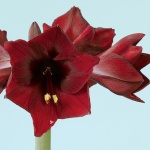 Offered in the 2014/2015 season by Royal Colors. Perhaps this is a new and unregistered form, but it could well be 'China Town' registered to P.J. Berbée in 2011. Deep black-red flowers (more than 4 per scape) open with notably pointed tips. The scapes are violet purple at the base, and gradually become gray-green near the apex, with a dark ring beneath the spathe valves. Tepal segments are all similar to one another, and definitely stubby and spade shaped. The flowers are not large, as the cultivar seems intended for the lucrative cut flower markets. The sheen and depth of color are remarkable. Similar to Penning's 'Mandela' which differs in not having violet shading in the shorter scapes.
Offered in the 2014/2015 season by Royal Colors. Perhaps this is a new and unregistered form, but it could well be 'China Town' registered to P.J. Berbée in 2011. Deep black-red flowers (more than 4 per scape) open with notably pointed tips. The scapes are violet purple at the base, and gradually become gray-green near the apex, with a dark ring beneath the spathe valves. Tepal segments are all similar to one another, and definitely stubby and spade shaped. The flowers are not large, as the cultivar seems intended for the lucrative cut flower markets. The sheen and depth of color are remarkable. Similar to Penning's 'Mandela' which differs in not having violet shading in the shorter scapes.
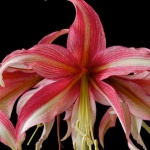 One of the more unusual "cybister" type amaryllis to make it to market, albeit through a back door. Bought as 'Inca', which was sold as a red variety along the lines of 'Ruby Meyer'. Rose tones over cream tepals that twist and undulate with abandon. Probably intended for the cutflower market. Dubbed "Shacoba" on some Asian sites.
One of the more unusual "cybister" type amaryllis to make it to market, albeit through a back door. Bought as 'Inca', which was sold as a red variety along the lines of 'Ruby Meyer'. Rose tones over cream tepals that twist and undulate with abandon. Probably intended for the cutflower market. Dubbed "Shacoba" on some Asian sites.
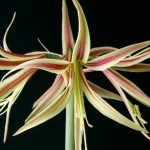 Ludwig hybrids were formerly posted to their website, often with numeric codes, meaning that they weren't registered yet. When Berbee took control of the amaryllis breeding, Ludwig’s presence as it had been known vanished. Hopefully they will name, register and release this one some day, it is entirely unique, and it deserves a name! This selection is quite tall, and the elegant 'cybister' form would make it an easy candidate for the cut flower market. This particular specimen was gotten as a substitute among a batch of 'Night Star' purchased in December 2010.
Ludwig hybrids were formerly posted to their website, often with numeric codes, meaning that they weren't registered yet. When Berbee took control of the amaryllis breeding, Ludwig’s presence as it had been known vanished. Hopefully they will name, register and release this one some day, it is entirely unique, and it deserves a name! This selection is quite tall, and the elegant 'cybister' form would make it an easy candidate for the cut flower market. This particular specimen was gotten as a substitute among a batch of 'Night Star' purchased in December 2010.
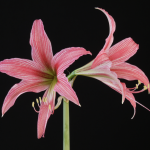 Purchased in 2003 at a local nursery, from a bulk bin. Clearly not 'Rio Negro', but this colorful little fellow was deemed charming enough to make some crosses with here at the amaryllis ranch. It may have been part of the Fred Meyer or Len Doran breeding efforts in California that was produced in small quantities before being dropped in favor of other cultivars.
Purchased in 2003 at a local nursery, from a bulk bin. Clearly not 'Rio Negro', but this colorful little fellow was deemed charming enough to make some crosses with here at the amaryllis ranch. It may have been part of the Fred Meyer or Len Doran breeding efforts in California that was produced in small quantities before being dropped in favor of other cultivars.
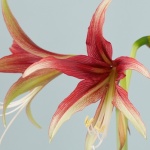 Emaryllis is mainly here to show Hippeastrum varieties sold widely in North America. This was made available in limited quantities by Royal Colors (through a link provided their Facebook subscribers) in early winter 2010. It is presumably a cutflower variety, being small-flowered and tall of stem. The coloration won't exactly floor you if you have grown other "cybister" types; it fits somewhere between 'La Paz' and 'Lima' in coloration...and being much like a red and green version of 'Santa Rosa.' It is a treat to have the availability of some of these cutflower types, and there is a niche market in unusual amaryllis that is wisely being tapped.
Emaryllis is mainly here to show Hippeastrum varieties sold widely in North America. This was made available in limited quantities by Royal Colors (through a link provided their Facebook subscribers) in early winter 2010. It is presumably a cutflower variety, being small-flowered and tall of stem. The coloration won't exactly floor you if you have grown other "cybister" types; it fits somewhere between 'La Paz' and 'Lima' in coloration...and being much like a red and green version of 'Santa Rosa.' It is a treat to have the availability of some of these cutflower types, and there is a niche market in unusual amaryllis that is wisely being tapped.
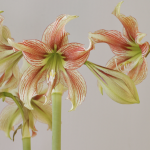 'Okapi' is an Emaryllis nickname for a vegetative sport of 'Giraffe', an amaryllis that makes a lot of offsets. One of those offsets was noted to have more richly colored flowers. They also have the habit of being slow to open as the tepal tips remain fused longer than normal, in the manner of 'Thai Thai'. This gives 'Okapi' more animated and lively qualities than its parent, but unfortunately the same 2-3 flowers per scape. The parentage of 'Giraffe' may be Hippeastrum (papilio x puniceum). Like 'Giraffe' this one is at its best allowed to clump up, it can then make many scapes, and the low bud count isn't such a deficit.
'Okapi' is an Emaryllis nickname for a vegetative sport of 'Giraffe', an amaryllis that makes a lot of offsets. One of those offsets was noted to have more richly colored flowers. They also have the habit of being slow to open as the tepal tips remain fused longer than normal, in the manner of 'Thai Thai'. This gives 'Okapi' more animated and lively qualities than its parent, but unfortunately the same 2-3 flowers per scape. The parentage of 'Giraffe' may be Hippeastrum (papilio x puniceum). Like 'Giraffe' this one is at its best allowed to clump up, it can then make many scapes, and the low bud count isn't such a deficit.
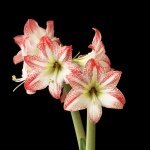 This curiosity showed up during the 2024-2025 season. It may be the product of a South American amaryllis grower/breeder. The photographed amaryllis was purchased as ‘Superstar’ from a mail order house. A follower of Emaryllis got the same by purchasing ‘Stargazer’ from Walmart. It was also seen as part of an unlabeled assortment as a potted plant. The flowers are very variable in terms of how much red marking occurs on the white face. The black cherry eye is consistent. Flower size is variable as well, but it makes it into the large flowered class. A beautiful mystery....for now! We’ve nicknamed it “Peppermint Crackle” as was suggested by a friend of Emaryllis.
This curiosity showed up during the 2024-2025 season. It may be the product of a South American amaryllis grower/breeder. The photographed amaryllis was purchased as ‘Superstar’ from a mail order house. A follower of Emaryllis got the same by purchasing ‘Stargazer’ from Walmart. It was also seen as part of an unlabeled assortment as a potted plant. The flowers are very variable in terms of how much red marking occurs on the white face. The black cherry eye is consistent. Flower size is variable as well, but it makes it into the large flowered class. A beautiful mystery....for now! We’ve nicknamed it “Peppermint Crackle” as was suggested by a friend of Emaryllis.
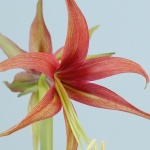 This little guy was gotten as one of the substitutes in the attempt to buy 'Kahlua' from Royal Colors in 2014. Their supplier apparently needed to offload some other varieties! This clone was gotten twice, so it was obviously entering production trials for the cutflower trade. With the green tones unevenly rising through the rusty red shades, it may not make the cut. On better roots it was moderately more even in its unevenness both in terms of coloration and twisting or bending of the mature tepals. Two flowers per scape seems the norm for now, but these were tiny bulbs. This little amaryllis has grown on me, but why, I cannot say. I've dubbed it 'Ruddy Waters' (cute, huh?) for the time being.
This little guy was gotten as one of the substitutes in the attempt to buy 'Kahlua' from Royal Colors in 2014. Their supplier apparently needed to offload some other varieties! This clone was gotten twice, so it was obviously entering production trials for the cutflower trade. With the green tones unevenly rising through the rusty red shades, it may not make the cut. On better roots it was moderately more even in its unevenness both in terms of coloration and twisting or bending of the mature tepals. Two flowers per scape seems the norm for now, but these were tiny bulbs. This little amaryllis has grown on me, but why, I cannot say. I've dubbed it 'Ruddy Waters' (cute, huh?) for the time being.
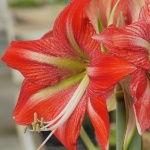 Showing up in 2014 as a substitute for the completely different 'Lime Flare,' this is one of Saad-Assaf's creations. It may have been seen in a group graphic of their 'Mediterranean' series, but it seems to have issues. Most flowers open showing considerable distortion or lopsided character along with uneven coloration. Things improve significantly if they are cut prior to opening, so perhaps there is just a production issue that impacted bulb health. We'll see if it is even named and introduced, but it will have to perform much better to get a gold star here.
Showing up in 2014 as a substitute for the completely different 'Lime Flare,' this is one of Saad-Assaf's creations. It may have been seen in a group graphic of their 'Mediterranean' series, but it seems to have issues. Most flowers open showing considerable distortion or lopsided character along with uneven coloration. Things improve significantly if they are cut prior to opening, so perhaps there is just a production issue that impacted bulb health. We'll see if it is even named and introduced, but it will have to perform much better to get a gold star here.
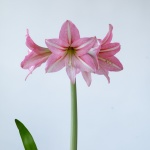 Bought as a box kit featuring photos of ‘Apple Blossom’ on discount after the 2023 winter holidays. A pleasant surprise! Currently only given a numeric designation on the grower/breeder’s site. Our 24 cm bulb made one scape that reached 58 cm tall. It was bedecked with five flowers measuring about 17 cm across. All signs point to a very nice coming introduction from the Israeli amaryllis/Hippeastrum producer. Cyclamen pink flowers with darker veins are bisected by a clean white star. Deeper color gathers towards the center, where a deep cherry red eye centers the bloom. It slots nicely between smaller ‘Pinkolo’ and more solid colored ‘Pink Flush’.
Bought as a box kit featuring photos of ‘Apple Blossom’ on discount after the 2023 winter holidays. A pleasant surprise! Currently only given a numeric designation on the grower/breeder’s site. Our 24 cm bulb made one scape that reached 58 cm tall. It was bedecked with five flowers measuring about 17 cm across. All signs point to a very nice coming introduction from the Israeli amaryllis/Hippeastrum producer. Cyclamen pink flowers with darker veins are bisected by a clean white star. Deeper color gathers towards the center, where a deep cherry red eye centers the bloom. It slots nicely between smaller ‘Pinkolo’ and more solid colored ‘Pink Flush’.
 This is what The Lobby is all about. Certainly this fine pink amaryllis from Saad-Assaf will get a proper name. A very nice solid pink. Update for 2023: It seems this one was finally released as ‘Rose Quartz’, so its time here in The Lobby is
This is what The Lobby is all about. Certainly this fine pink amaryllis from Saad-Assaf will get a proper name. A very nice solid pink. Update for 2023: It seems this one was finally released as ‘Rose Quartz’, so its time here in The Lobby is
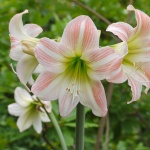 Barnhoorn Hippeastrum, presumably. This little guy is basically a warmer pink 'Apple Blossom' in miniature. While the coloration isn't particularly vivid, it is a little charmer. Received in a "hardy mix" in 2008, and never to be seen again. The closest I see in promo photos leads me to believe this is either 'Jolly Rascal', or a predecessor to it.
Barnhoorn Hippeastrum, presumably. This little guy is basically a warmer pink 'Apple Blossom' in miniature. While the coloration isn't particularly vivid, it is a little charmer. Received in a "hardy mix" in 2008, and never to be seen again. The closest I see in promo photos leads me to believe this is either 'Jolly Rascal', or a predecessor to it.
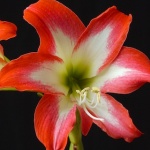 Barnhoorn Hippeastrum, presumably. Appearing as sibling to 'Flamingo', I wish this had been in good enough health to carry forward another year. It could have upstaged the debut of 'Très Chic' with its huge white center and thick outer band of rose. A terrible infestation of bulb scale mites sadly took it down.
Barnhoorn Hippeastrum, presumably. Appearing as sibling to 'Flamingo', I wish this had been in good enough health to carry forward another year. It could have upstaged the debut of 'Très Chic' with its huge white center and thick outer band of rose. A terrible infestation of bulb scale mites sadly took it down.
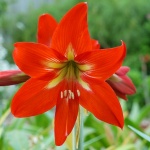 Barnhoorn Hippeastrum, presumably. One of the first standouts in the Sonatini range of hardy miniature amaryllis has been 'Balentino'. Offered initially as 'Valentino', it features a pronounced white midrib heart. This similar, but different (more diffuse white heart and less rounded face) clone was being passed off as the aforementioned variety. Good enough in its own right, being a sort of smaller H. x johnsonii stand in, as it was indeed cold hardy outdoors and has bloomed well. But there can be only one 'Balantino/Balentino' or 'Valentino/Valantino', and this is not it.
Barnhoorn Hippeastrum, presumably. One of the first standouts in the Sonatini range of hardy miniature amaryllis has been 'Balentino'. Offered initially as 'Valentino', it features a pronounced white midrib heart. This similar, but different (more diffuse white heart and less rounded face) clone was being passed off as the aforementioned variety. Good enough in its own right, being a sort of smaller H. x johnsonii stand in, as it was indeed cold hardy outdoors and has bloomed well. But there can be only one 'Balantino/Balentino' or 'Valentino/Valantino', and this is not it.
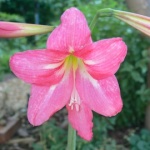 Barnhoorn Hippeastrum, presumably. Mislabeled as the warm bicolor 'Veneto', this one makes me think it is an earlier breeding effort that at last has yielded the beautiful 'Sweet Sixteen'. Bright phlox pink with extended white midribs and a lax trumpet form. Vibrant, but not a strong grower.
Barnhoorn Hippeastrum, presumably. Mislabeled as the warm bicolor 'Veneto', this one makes me think it is an earlier breeding effort that at last has yielded the beautiful 'Sweet Sixteen'. Bright phlox pink with extended white midribs and a lax trumpet form. Vibrant, but not a strong grower.
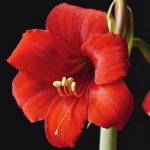 Barnhoorn Hippeastrum, presumably. Gotten in a mix of unlabeled "hardy garden amaryllis" from Breck's Bulbs in 2008, this one will likely remain an un-named mystery. Solid scarlet red, this miniature has long tepal-tubes, and yet a full rounded face. OK, I can see that it wouldn't have flown off the shelves marketed under its own name, but intriguing nonetheless.
Barnhoorn Hippeastrum, presumably. Gotten in a mix of unlabeled "hardy garden amaryllis" from Breck's Bulbs in 2008, this one will likely remain an un-named mystery. Solid scarlet red, this miniature has long tepal-tubes, and yet a full rounded face. OK, I can see that it wouldn't have flown off the shelves marketed under its own name, but intriguing nonetheless.
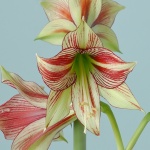 Offered by Royal Colors in 2014, this is clearly a hybrid using Hippeastrum papilio. With an average of only 2 flowers per tall scape, even its use to the cutflower industry is limited. For the rest of us, it offers a glimpse into to someone's breeding program in a lovely way.
Offered by Royal Colors in 2014, this is clearly a hybrid using Hippeastrum papilio. With an average of only 2 flowers per tall scape, even its use to the cutflower industry is limited. For the rest of us, it offers a glimpse into to someone's breeding program in a lovely way.
 Crosses between Sprekelia formosissima and Hippeastrum and Zephyranthes seem to point to the Aztec, or Jacobean lily as genetic bridge among New World amaryllids. In the 1970's, a young man in India in the 1970’s crossed it with Hippeastrum to make what is now known as x Hippeastrelia. He named the first selection ‘Durga Pradhan’ for his grandfather. While not just any Hippeastrum will cross to Sprekelia, there does seem to be plenty of possibility beyond the form seen here. Perhaps a renewed effort to hybridize among newer tetraploid Hippeastrum and Sprekelia will lead to more variety of form and color down the road. The hybrid is fairly frost hardy, but winter moisture may contribute to poor flowering in spring. There are a handful of selections (‘Mystique’ ‘Orient Red’, 'Red Beauty', 'Red Rover') available from specialty nurseries.
Crosses between Sprekelia formosissima and Hippeastrum and Zephyranthes seem to point to the Aztec, or Jacobean lily as genetic bridge among New World amaryllids. In the 1970's, a young man in India in the 1970’s crossed it with Hippeastrum to make what is now known as x Hippeastrelia. He named the first selection ‘Durga Pradhan’ for his grandfather. While not just any Hippeastrum will cross to Sprekelia, there does seem to be plenty of possibility beyond the form seen here. Perhaps a renewed effort to hybridize among newer tetraploid Hippeastrum and Sprekelia will lead to more variety of form and color down the road. The hybrid is fairly frost hardy, but winter moisture may contribute to poor flowering in spring. There are a handful of selections (‘Mystique’ ‘Orient Red’, 'Red Beauty', 'Red Rover') available from specialty nurseries.
 2010, Berbee Amarylliscultures. Grown primarily for the European cut-flower market, this one escaped in a box kit marked ‘Amigo’. Beautiful warm apricot orange with hints of flamingo rose near the inner midribs. An exquisite amaryllis; unfortunately this one showed virus symptoms upon growing out. The image is a terrific match for the registry description and stock photos, but certainty is not 100%.
2010, Berbee Amarylliscultures. Grown primarily for the European cut-flower market, this one escaped in a box kit marked ‘Amigo’. Beautiful warm apricot orange with hints of flamingo rose near the inner midribs. An exquisite amaryllis; unfortunately this one showed virus symptoms upon growing out. The image is a terrific match for the registry description and stock photos, but certainty is not 100%.
 This beautiful amaryllis showed up at retailers for a couple of years around 2003-2005, then seemingly disappeared. A nice "mini" with soft orange and white blooms. Quite beautiful, and favored over the paler and more pinkish 'Amoretta.' Emaryllis finds that it does still show up on the Leo Berbee (North America) site. It is unclear whether this is the same 'Table Decoration' as registered by Ludwig/Berbee in 1967. Like a miniature 'Nagano.'
This beautiful amaryllis showed up at retailers for a couple of years around 2003-2005, then seemingly disappeared. A nice "mini" with soft orange and white blooms. Quite beautiful, and favored over the paler and more pinkish 'Amoretta.' Emaryllis finds that it does still show up on the Leo Berbee (North America) site. It is unclear whether this is the same 'Table Decoration' as registered by Ludwig/Berbee in 1967. Like a miniature 'Nagano.'
 Purchased as a box kit labeled as 'Red Sensation'. It turned out not to be the huge scarlet red amaryllis expected, but this extremely dark and silky red of modest size and impeccable form. The red is so dark, so even, and the form is so flawless that this simply can not be some un-named seedling. My suspicion is that it is 'Dordogne', which has been produced for the cutflower industry. An absolutely stunning flower. There may be more and more fine hybrids with nearly black red coloration, but this one is still special.
Purchased as a box kit labeled as 'Red Sensation'. It turned out not to be the huge scarlet red amaryllis expected, but this extremely dark and silky red of modest size and impeccable form. The red is so dark, so even, and the form is so flawless that this simply can not be some un-named seedling. My suspicion is that it is 'Dordogne', which has been produced for the cutflower industry. An absolutely stunning flower. There may be more and more fine hybrids with nearly black red coloration, but this one is still special.
 Offered in the 2014/2015 season by Royal Colors. Perhaps this is a new and unregistered form, but it could well be 'China Town' registered to P.J. Berbée in 2011. Deep black-red flowers (more than 4 per scape) open with notably pointed tips. The scapes are violet purple at the base, and gradually become gray-green near the apex, with a dark ring beneath the spathe valves. Tepal segments are all similar to one another, and definitely stubby and spade shaped. The flowers are not large, as the cultivar seems intended for the lucrative cut flower markets. The sheen and depth of color are remarkable. Similar to Penning's 'Mandela' which differs in not having violet shading in the shorter scapes.
Offered in the 2014/2015 season by Royal Colors. Perhaps this is a new and unregistered form, but it could well be 'China Town' registered to P.J. Berbée in 2011. Deep black-red flowers (more than 4 per scape) open with notably pointed tips. The scapes are violet purple at the base, and gradually become gray-green near the apex, with a dark ring beneath the spathe valves. Tepal segments are all similar to one another, and definitely stubby and spade shaped. The flowers are not large, as the cultivar seems intended for the lucrative cut flower markets. The sheen and depth of color are remarkable. Similar to Penning's 'Mandela' which differs in not having violet shading in the shorter scapes.
 One of the more unusual "cybister" type amaryllis to make it to market, albeit through a back door. Bought as 'Inca', which was sold as a red variety along the lines of 'Ruby Meyer'. Rose tones over cream tepals that twist and undulate with abandon. Probably intended for the cutflower market. Dubbed "Shacoba" on some Asian sites.
One of the more unusual "cybister" type amaryllis to make it to market, albeit through a back door. Bought as 'Inca', which was sold as a red variety along the lines of 'Ruby Meyer'. Rose tones over cream tepals that twist and undulate with abandon. Probably intended for the cutflower market. Dubbed "Shacoba" on some Asian sites.
 Ludwig hybrids were formerly posted to their website, often with numeric codes, meaning that they weren't registered yet. When Berbee took control of the amaryllis breeding, Ludwig’s presence as it had been known vanished. Hopefully they will name, register and release this one some day, it is entirely unique, and it deserves a name! This selection is quite tall, and the elegant 'cybister' form would make it an easy candidate for the cut flower market. This particular specimen was gotten as a substitute among a batch of 'Night Star' purchased in December 2010.
Ludwig hybrids were formerly posted to their website, often with numeric codes, meaning that they weren't registered yet. When Berbee took control of the amaryllis breeding, Ludwig’s presence as it had been known vanished. Hopefully they will name, register and release this one some day, it is entirely unique, and it deserves a name! This selection is quite tall, and the elegant 'cybister' form would make it an easy candidate for the cut flower market. This particular specimen was gotten as a substitute among a batch of 'Night Star' purchased in December 2010.
 Purchased in 2003 at a local nursery, from a bulk bin. Clearly not 'Rio Negro', but this colorful little fellow was deemed charming enough to make some crosses with here at the amaryllis ranch. It may have been part of the Fred Meyer or Len Doran breeding efforts in California that was produced in small quantities before being dropped in favor of other cultivars.
Purchased in 2003 at a local nursery, from a bulk bin. Clearly not 'Rio Negro', but this colorful little fellow was deemed charming enough to make some crosses with here at the amaryllis ranch. It may have been part of the Fred Meyer or Len Doran breeding efforts in California that was produced in small quantities before being dropped in favor of other cultivars.
 Emaryllis is mainly here to show Hippeastrum varieties sold widely in North America. This was made available in limited quantities by Royal Colors (through a link provided their Facebook subscribers) in early winter 2010. It is presumably a cutflower variety, being small-flowered and tall of stem. The coloration won't exactly floor you if you have grown other "cybister" types; it fits somewhere between 'La Paz' and 'Lima' in coloration...and being much like a red and green version of 'Santa Rosa.' It is a treat to have the availability of some of these cutflower types, and there is a niche market in unusual amaryllis that is wisely being tapped.
Emaryllis is mainly here to show Hippeastrum varieties sold widely in North America. This was made available in limited quantities by Royal Colors (through a link provided their Facebook subscribers) in early winter 2010. It is presumably a cutflower variety, being small-flowered and tall of stem. The coloration won't exactly floor you if you have grown other "cybister" types; it fits somewhere between 'La Paz' and 'Lima' in coloration...and being much like a red and green version of 'Santa Rosa.' It is a treat to have the availability of some of these cutflower types, and there is a niche market in unusual amaryllis that is wisely being tapped.
 'Okapi' is an Emaryllis nickname for a vegetative sport of 'Giraffe', an amaryllis that makes a lot of offsets. One of those offsets was noted to have more richly colored flowers. They also have the habit of being slow to open as the tepal tips remain fused longer than normal, in the manner of 'Thai Thai'. This gives 'Okapi' more animated and lively qualities than its parent, but unfortunately the same 2-3 flowers per scape. The parentage of 'Giraffe' may be Hippeastrum (papilio x puniceum). Like 'Giraffe' this one is at its best allowed to clump up, it can then make many scapes, and the low bud count isn't such a deficit.
'Okapi' is an Emaryllis nickname for a vegetative sport of 'Giraffe', an amaryllis that makes a lot of offsets. One of those offsets was noted to have more richly colored flowers. They also have the habit of being slow to open as the tepal tips remain fused longer than normal, in the manner of 'Thai Thai'. This gives 'Okapi' more animated and lively qualities than its parent, but unfortunately the same 2-3 flowers per scape. The parentage of 'Giraffe' may be Hippeastrum (papilio x puniceum). Like 'Giraffe' this one is at its best allowed to clump up, it can then make many scapes, and the low bud count isn't such a deficit.
 This curiosity showed up during the 2024-2025 season. It may be the product of a South American amaryllis grower/breeder. The photographed amaryllis was purchased as ‘Superstar’ from a mail order house. A follower of Emaryllis got the same by purchasing ‘Stargazer’ from Walmart. It was also seen as part of an unlabeled assortment as a potted plant. The flowers are very variable in terms of how much red marking occurs on the white face. The black cherry eye is consistent. Flower size is variable as well, but it makes it into the large flowered class. A beautiful mystery....for now! We’ve nicknamed it “Peppermint Crackle” as was suggested by a friend of Emaryllis.
This curiosity showed up during the 2024-2025 season. It may be the product of a South American amaryllis grower/breeder. The photographed amaryllis was purchased as ‘Superstar’ from a mail order house. A follower of Emaryllis got the same by purchasing ‘Stargazer’ from Walmart. It was also seen as part of an unlabeled assortment as a potted plant. The flowers are very variable in terms of how much red marking occurs on the white face. The black cherry eye is consistent. Flower size is variable as well, but it makes it into the large flowered class. A beautiful mystery....for now! We’ve nicknamed it “Peppermint Crackle” as was suggested by a friend of Emaryllis.
 This little guy was gotten as one of the substitutes in the attempt to buy 'Kahlua' from Royal Colors in 2014. Their supplier apparently needed to offload some other varieties! This clone was gotten twice, so it was obviously entering production trials for the cutflower trade. With the green tones unevenly rising through the rusty red shades, it may not make the cut. On better roots it was moderately more even in its unevenness both in terms of coloration and twisting or bending of the mature tepals. Two flowers per scape seems the norm for now, but these were tiny bulbs. This little amaryllis has grown on me, but why, I cannot say. I've dubbed it 'Ruddy Waters' (cute, huh?) for the time being.
This little guy was gotten as one of the substitutes in the attempt to buy 'Kahlua' from Royal Colors in 2014. Their supplier apparently needed to offload some other varieties! This clone was gotten twice, so it was obviously entering production trials for the cutflower trade. With the green tones unevenly rising through the rusty red shades, it may not make the cut. On better roots it was moderately more even in its unevenness both in terms of coloration and twisting or bending of the mature tepals. Two flowers per scape seems the norm for now, but these were tiny bulbs. This little amaryllis has grown on me, but why, I cannot say. I've dubbed it 'Ruddy Waters' (cute, huh?) for the time being.
 Showing up in 2014 as a substitute for the completely different 'Lime Flare,' this is one of Saad-Assaf's creations. It may have been seen in a group graphic of their 'Mediterranean' series, but it seems to have issues. Most flowers open showing considerable distortion or lopsided character along with uneven coloration. Things improve significantly if they are cut prior to opening, so perhaps there is just a production issue that impacted bulb health. We'll see if it is even named and introduced, but it will have to perform much better to get a gold star here.
Showing up in 2014 as a substitute for the completely different 'Lime Flare,' this is one of Saad-Assaf's creations. It may have been seen in a group graphic of their 'Mediterranean' series, but it seems to have issues. Most flowers open showing considerable distortion or lopsided character along with uneven coloration. Things improve significantly if they are cut prior to opening, so perhaps there is just a production issue that impacted bulb health. We'll see if it is even named and introduced, but it will have to perform much better to get a gold star here.
 Bought as a box kit featuring photos of ‘Apple Blossom’ on discount after the 2023 winter holidays. A pleasant surprise! Currently only given a numeric designation on the grower/breeder’s site. Our 24 cm bulb made one scape that reached 58 cm tall. It was bedecked with five flowers measuring about 17 cm across. All signs point to a very nice coming introduction from the Israeli amaryllis/Hippeastrum producer. Cyclamen pink flowers with darker veins are bisected by a clean white star. Deeper color gathers towards the center, where a deep cherry red eye centers the bloom. It slots nicely between smaller ‘Pinkolo’ and more solid colored ‘Pink Flush’.
Bought as a box kit featuring photos of ‘Apple Blossom’ on discount after the 2023 winter holidays. A pleasant surprise! Currently only given a numeric designation on the grower/breeder’s site. Our 24 cm bulb made one scape that reached 58 cm tall. It was bedecked with five flowers measuring about 17 cm across. All signs point to a very nice coming introduction from the Israeli amaryllis/Hippeastrum producer. Cyclamen pink flowers with darker veins are bisected by a clean white star. Deeper color gathers towards the center, where a deep cherry red eye centers the bloom. It slots nicely between smaller ‘Pinkolo’ and more solid colored ‘Pink Flush’.
 Barnhoorn Hippeastrum, presumably. This little guy is basically a warmer pink 'Apple Blossom' in miniature. While the coloration isn't particularly vivid, it is a little charmer. Received in a "hardy mix" in 2008, and never to be seen again. The closest I see in promo photos leads me to believe this is either 'Jolly Rascal', or a predecessor to it.
Barnhoorn Hippeastrum, presumably. This little guy is basically a warmer pink 'Apple Blossom' in miniature. While the coloration isn't particularly vivid, it is a little charmer. Received in a "hardy mix" in 2008, and never to be seen again. The closest I see in promo photos leads me to believe this is either 'Jolly Rascal', or a predecessor to it.
 Barnhoorn Hippeastrum, presumably. Appearing as sibling to 'Flamingo', I wish this had been in good enough health to carry forward another year. It could have upstaged the debut of 'Très Chic' with its huge white center and thick outer band of rose. A terrible infestation of bulb scale mites sadly took it down.
Barnhoorn Hippeastrum, presumably. Appearing as sibling to 'Flamingo', I wish this had been in good enough health to carry forward another year. It could have upstaged the debut of 'Très Chic' with its huge white center and thick outer band of rose. A terrible infestation of bulb scale mites sadly took it down.
 Barnhoorn Hippeastrum, presumably. One of the first standouts in the Sonatini range of hardy miniature amaryllis has been 'Balentino'. Offered initially as 'Valentino', it features a pronounced white midrib heart. This similar, but different (more diffuse white heart and less rounded face) clone was being passed off as the aforementioned variety. Good enough in its own right, being a sort of smaller H. x johnsonii stand in, as it was indeed cold hardy outdoors and has bloomed well. But there can be only one 'Balantino/Balentino' or 'Valentino/Valantino', and this is not it.
Barnhoorn Hippeastrum, presumably. One of the first standouts in the Sonatini range of hardy miniature amaryllis has been 'Balentino'. Offered initially as 'Valentino', it features a pronounced white midrib heart. This similar, but different (more diffuse white heart and less rounded face) clone was being passed off as the aforementioned variety. Good enough in its own right, being a sort of smaller H. x johnsonii stand in, as it was indeed cold hardy outdoors and has bloomed well. But there can be only one 'Balantino/Balentino' or 'Valentino/Valantino', and this is not it.
 Barnhoorn Hippeastrum, presumably. Gotten in a mix of unlabeled "hardy garden amaryllis" from Breck's Bulbs in 2008, this one will likely remain an un-named mystery. Solid scarlet red, this miniature has long tepal-tubes, and yet a full rounded face. OK, I can see that it wouldn't have flown off the shelves marketed under its own name, but intriguing nonetheless.
Barnhoorn Hippeastrum, presumably. Gotten in a mix of unlabeled "hardy garden amaryllis" from Breck's Bulbs in 2008, this one will likely remain an un-named mystery. Solid scarlet red, this miniature has long tepal-tubes, and yet a full rounded face. OK, I can see that it wouldn't have flown off the shelves marketed under its own name, but intriguing nonetheless.
 Crosses between Sprekelia formosissima and Hippeastrum and Zephyranthes seem to point to the Aztec, or Jacobean lily as genetic bridge among New World amaryllids. In the 1970's, a young man in India in the 1970’s crossed it with Hippeastrum to make what is now known as x Hippeastrelia. He named the first selection ‘Durga Pradhan’ for his grandfather. While not just any Hippeastrum will cross to Sprekelia, there does seem to be plenty of possibility beyond the form seen here. Perhaps a renewed effort to hybridize among newer tetraploid Hippeastrum and Sprekelia will lead to more variety of form and color down the road. The hybrid is fairly frost hardy, but winter moisture may contribute to poor flowering in spring. There are a handful of selections (‘Mystique’ ‘Orient Red’, 'Red Beauty', 'Red Rover') available from specialty nurseries.
Crosses between Sprekelia formosissima and Hippeastrum and Zephyranthes seem to point to the Aztec, or Jacobean lily as genetic bridge among New World amaryllids. In the 1970's, a young man in India in the 1970’s crossed it with Hippeastrum to make what is now known as x Hippeastrelia. He named the first selection ‘Durga Pradhan’ for his grandfather. While not just any Hippeastrum will cross to Sprekelia, there does seem to be plenty of possibility beyond the form seen here. Perhaps a renewed effort to hybridize among newer tetraploid Hippeastrum and Sprekelia will lead to more variety of form and color down the road. The hybrid is fairly frost hardy, but winter moisture may contribute to poor flowering in spring. There are a handful of selections (‘Mystique’ ‘Orient Red’, 'Red Beauty', 'Red Rover') available from specialty nurseries.






Leave a Reply